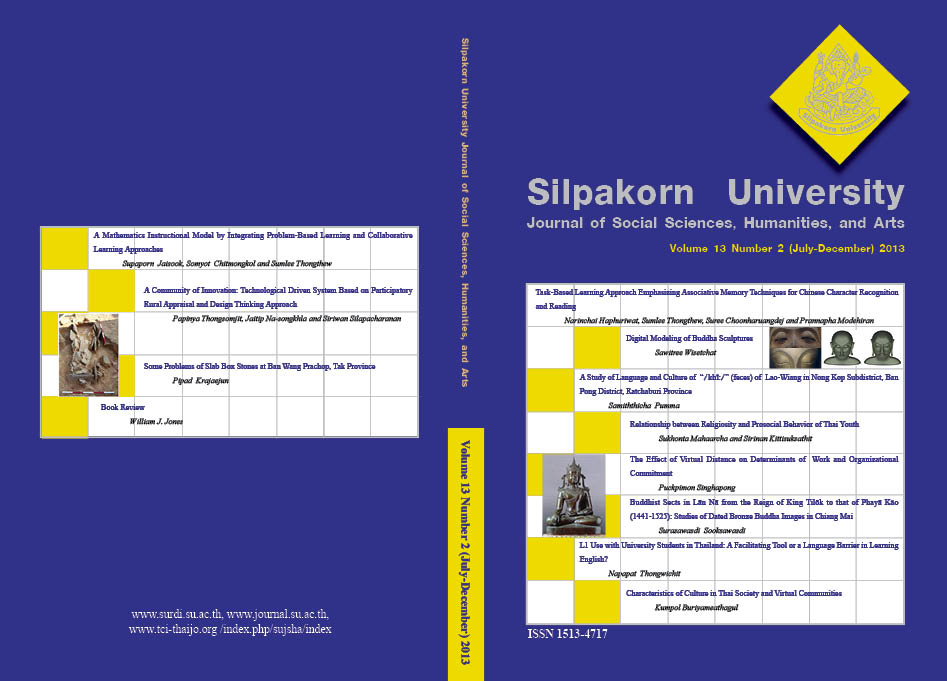A Mathematics Instructional Model by Integrating Problem-Based Learning and Collaborative Learning Approaches
Main Article Content
Abstract
According to several researches conducted by several organizations, such as Ministry of Education (MOE), Institute for the Promotion of Teaching Science and Technology (IPST), and National Institute of Educational
Testing Service (NIETS), it was found that most Thai students did not succeed in learning mathematics in terms of content and mathematics processes. This research results were consistent with the facts and findings
of several surveys which were conducted based on the situation happening in real life. Therefore, problems in learning mathematics could be concluded in 3 significant points, including (1) mathematical problem solving ability, (2) mathematical communication ability, and (3) mathematical connection ability. The purposes of this research included (1) to develop a mathematics instructional model by integrating problem-based learning approach and collaborative learning approach to enhance mathematical problem solving, communication, and connection abilities of sixth grade students, and (2) to study the effects of the use of the instructional model.
The research procedure included two steps. The first step was the development of instructional model and the second step was the experiment of the developed instructional model in classrooms. Integrating problem-
based learning approach and collaborative learning approach and also analyzing and synthesizing the related concepts, theories, and researches were brought to develop the model. The instructional model was further
experimented with the sample group of sixth grade students. The samples consisted of two classrooms, one experimental group and one control group, in which there were 24 students each, at Wat Taranaram School under the Suratthani Primary Educational Service Area Office 2. The experimental period covered 38 hours conducted by using the research tools, including the lesson plans under the developed model, conventional lesson plans, as well as tests for mathematical problem-solving, communication, and connection abilities. Quantitative data were analyzed by using means of arithmetic mean (x̄), standard deviation (S.D.) and t-test.The research results could be summarized as follows:-
1. The developed instructional model included four elements which are (1) principles, (2) objectives, (3) steps of instructional process, and (4) learning assessment and evaluation. In addition, the instructional process consisted of four steps, including (1) encouraging students’ attention in encountering challenging problems, (2) practicing enthusiastically for searching knowledge, (3) collaboratively examining their knowledge and concluding by group consensus, and (4) applying the knowledge.
2. The developed instructional model was efficient and could be used to enhance students’ mathematical problem solving, communication, and connection abilities as follows:
2.1 Mathematical problem solving, communication, and connection abilities at the post-learning stage of the experimental group were significantly higher than those of the control group at the significant level of .05; and
2.2 Mathematical problem solving, communication, and connection abilities of the experimental group at the post-learning stage were significantly higher than those abilities at the pre-learning stage at the significant level of .05.
Downloads
Download data is not yet available.
Article Details
How to Cite
Jaisook, S., Chitmongkol, S., & Thongthew, S. (2013). A Mathematics Instructional Model by Integrating Problem-Based Learning and Collaborative Learning Approaches. Humanities, Arts and Social Sciences Studies, 13(2), 271–294. retrieved from https://so02.tci-thaijo.org/index.php/hasss/article/view/14507
Section
Articles
All rights reserved. Apart from citations for the purposes of research, private study, or criticism and review,no part of this publication may be reproduced, stored or transmitted in any other form without prior written permission by the publisher.


